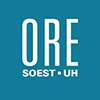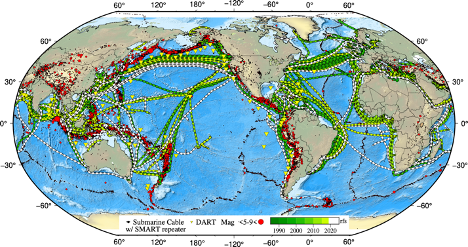To subscribe to the ORE seminar mailing list, click here.
For a (working draft) list of upcoming seminars, click here.
If you are interested in giving an ORE seminar, please contact us at nosal [at] hawaii [dot] edu.
Seminar: Micro-rosette: a novel means of sampling for autonomous platforms
Ellen Briggs, PhD Assistant Professor Department of Ocean & Resources Engineering University of Hawai'i at Mānoa We have been developing a ‘micro-rosette’ for collecting water samples on mobile platforms such as profiling floats. Not all sensing technologies can measure at the rate required for mobile platforms so here we use this micro-rosette to collect and store samples to be measured at a later time. For Argo-style profiling floats, there is a ~9-day park cycle between profiles during which the sample analyses can be completed. The original aim was to measure DIC (dissolved inorganic carbon) through a method using a gas
Seminar: Regional Scale Numerical Modeling of Wave Propagation and Transformation in Icy Waters – Capabilities and Challenges
Hongtao Li, PhD Centre for Sustainable Arctic Marine and Coastal Technology Department of Civil and Environmental Engineering Norwegian University of Science and Technology (NTNU), Trondheim, Norway In the past several decades, it has been observed obvious diminishing trend of ice cover in the polar regions. This opens the possibility for using Northern Sea route all year round. Nevertheless, with the retreat of ice cover, the fetch for waves to grow also increases. Consequently, wave climate deteriorates in both Arctic and Antarctic. In the meantime, the human activities in these regions such as fishing, tourism as well as exploration of hydrocarbon
Seminar: Honouliuli Wastewater Outfall Alternatives Evaluation
Dr. Dayananda Vithanage Director of Engineering, Oceanit *Abstract is not yet available.* ***Please join us ten minutes early for a virtual coffee hour hosted by Dr. Deniz Gedikli.*** Join Zoom Meeting Meeting ID: 958 5874 1165 Passcode: 545601
Seminar: SMART Subsea Cables for Observing the Ocean and Earth: An Update
Bruce Howe Ocean and Resources Engineering School of Ocean and Earth Science and Technology University of Hawaii at Manoa JTF SMART Subsea Cables (Joint Task Force, Science Monitoring And Reliable Telecommunications, 1) is working to integrate environmental sensors for ocean bottom temperature, pressure and seismic acceleration into submarine telecommunications cables. The purpose of SMART Cables is supporting climate and ocean observation, sea level monitoring, observations of Earth structure, and tsunami and earthquake early warning and disaster risk reduction. Recent advances include regional SMART pilot systems that are the first steps to trans-ocean and global implementation. Building on the OceanObs’19 conference
Seminar: Fluid-Structure Interactions: From Fundamentals of Flow-induced Vibration to Applications in Energy Harvesting
Banafsheh Seyed-Aghazadeh, PhD Mechanical Engineering Department, University of Massachusetts, Dartmouth When a flexible or flexibly-mounted structure is placed in fluid flow, it can deform or oscillate. The deformation or oscillation of the structure will result in the change of flow forces, which in turn will result in the change of the structure’s deformation or oscillation. This is called a Fluid-Structure Interactions (FSI) problem and the oscillation is called Flow-Induced Vibration (FIV). FIV has significant implications for a number of physical systems, from aeolian harps to power transmission lines, towing cables, undersea pipelines, drilling risers and mooring lines used to stabilize
Experiments and Interpretation of Ice-Induced Vibrations of Offshore Structures
Dr. Torodd Nord Associate Professor Department of Ocean Operations and Civil Engineering Norwegian University of Science and Technology (NTNU) When drifting sea ice interacts with a structure, it may result in structural vibrations hence ice-induced vibration. With the potential to harm the structural integrity, secondary installations and operational safety, ice-induced vibration is an important problem that needs to be addressed in structural design. Since the first deployment of Arctic offshore platforms in Cook Inlet, Alaska in 1960s, extensive measurement campaigns have brought significant attention and knowledge to ice-induced vibrations. With today’s growing demand for renewable energy, the development of offshore
Seminar: The Challenges and Capabilities of Free-Floating Autonomous Robots for Exploration of Extreme Environments
Corina Barbalata, PhD Assistant Professor Department of Mechanical and Industrial Engineering, Louisiana State University The Deep Space and the Deep Ocean are very similar in the sense that they are positioned at the end of continuum of extreme environments and pressures, that without the advancement of technology humans cannot access it. The advancements of robotics allowed us to access areas that have never been reached before and see details of wonders that were previously hidden to the human eye, all while reducing costs and increasing safety for space and ocean exploration. Nevertheless, robots used for space and ocean exploration still struggle with the environmental hazards. Moreover, if
Seminar: Engineering Cutting-Edge Solutions at Martin Defense Group
Charlie Field Mechanical Engineer Martin Defense Group, Honolulu, Hawaii Charlie Field is a graduate of the Ocean and Resources Engineering department, and earned his Master’s Degree from UH in 2012. During his time in the program, he interned at a local engineering company, Navatek, and was hired full-time as a Mechanical Engineer. Navatek is now Martin Defense Group, a leader in developing cutting-edge solutions in the defense and maritime industries. Leading the way in research, engineering, design, and innovation, the team of scientists and engineers believe in finding solutions that don’t just innovate, but that spark lasting change. Through partnerships
Seminar: Unlocking Opportunity with Data Science – Digital Twin for Deep Water Jumper VIV and Beyond
Haining Zheng, Ph.D. Advanced Research Data Scientist Data Analytics Group, Modelling & Optimization, MST, PTD ExxonMobil Research and Engineering Company As Data Science advances and increasingly large amounts of data become readily available via various Industrial Internet of Things (IIoT) projects, the energy industry is going through massive digital transformation to unlock enormous opportunities. In this talk, I will first give an overview of Data Science at energy companies, especially ExxonMobil, and then I will talk over three case studies of digital transformation in Energy Industry (1) Manufacturing Data Lake– efficient access to global manufacturing data (2) DEEVA: a deep learning
MS Plan A Defense: A fatigue analysis of the No-WEC mooring system at the U.S. Navy Wave Energy Test Site off Oʻahu, Hawaiʻi
Cameron Morrow Graduate Student Department of Ocean and Resources Engineering University of Hawai'i In order to reduce carbon emissions, there is a pressing need to look for alternative fuel sources. Energy created by renewable sources is the way of the future. One of the emerging renewable energy technologies is wave energy. The theoretical gross power generated from waves is 3.7 TW, but the estimated total net power is 3 TW. The Wave Energy Test Site (WETS), off the coast of Marine Corps Base Hawaiʻi, provides a unique location for the full-scale validation of Wave Energy Conversion (WEC) devices in the
Seminar: U.S. Army Corps of Engineers, Honolulu District Coastal Engineering Program Overview
Justin Goo, P.E. Chief, Civil Works Technical Branch U.S. Army Corps of Engineers, Honolulu District The U.S. Army Corps of Engineers, Honolulu District Civil Works Program delivers water resource development solutions including navigation safety, hurricane and storm risk management, ecosystem restoration, hydropower, and recreation. The Honolulu District area of responsibility includes State of Hawaii and the U.S. Territories of Guam, American Samoa, and the Commonwealth of the Northern Marianas Islands. This guest lecture intends to provide an informational briefing on the Honolulu District's coastal engineering mission which involves planning analysis, engineering and design, engineering support during construction, and operations and
Capstone Design Project Seminar: Feasibility of LNG as a transition fuel to 100% renewable energy for Hawaii
Andi Erickson Julianne Kalksma Stefan Mrozewski Giannicola Tumino Department of Ocean and Resources Engineering School of Ocean and Earth Science and Technology University of Hawai'i at Mānoa The State of Hawaii has passed legislation requiring the use of 100% renewable energy by 2045. Yet Hawaii generates most of its electricity from fuel oil and coal and less than a third through renewable energy sources. Whether or not the 100% renewables mandate is achievable by 2045, there exists an opportunity for a transitional fuel source for the island of Oahu that is both cleaner than the current fossil fuel mix and

